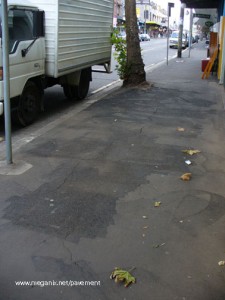Canberra writer Doug Fry is Pavement Graffiti’s inaugural guest spotter.
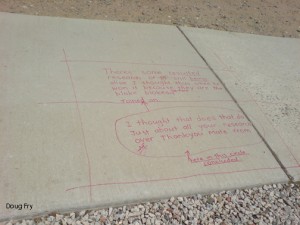 Apart from a failed first year university class (and my weekly trash TV fix of Bones) I don’t really have any experience in the field of psychology, so I’m only making a vaguely educated guess when I say that the author/illustrator of this work is probably a paranoid schizophrenic.
Apart from a failed first year university class (and my weekly trash TV fix of Bones) I don’t really have any experience in the field of psychology, so I’m only making a vaguely educated guess when I say that the author/illustrator of this work is probably a paranoid schizophrenic.
The author/illustrator is a gentleman who appears to be in his early 40s, and his chaotic ‘thought pattern’-type works can occasionally be spotted on public surfaces – bus shelters, powerline poles, shopping centre walls – around the inner southern suburbs of Canberra. This particular work was done on the footpath along Macgregor Street in Deakin, not far from the local shopping centre. 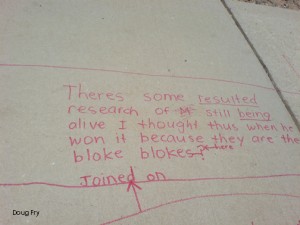
I passed the gentleman in the middle of sketching this particular ‘thought pattern’ during a stroll to fetch some groceries in December 2008. On my way home, he was sitting on a nearby bench, his work complete, so I stopped to chat with him – unsuccessfully. The gentleman immediately grew suspicious of my attention, muttered a few words, and then walked off in a hurry, leaving the mystery of his works intact. Â
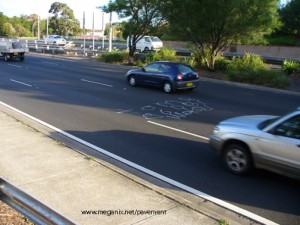 Some people take huge risks to put their tags up (or, in this case, down). And some people also take big risks to get a photo. These two examples are on the Warringah Freeway near Naremburn. It’s late afternoon and most of the traffic is heading north away from the city. But in the mornings the volume of traffic over these tags is enormous. So they have an audience of thousands – if anyone actually notices them. What’s amazing is how long they’ve lasted without being worn away. The photograph was taken in May and they are still there three months later.
Some people take huge risks to put their tags up (or, in this case, down). And some people also take big risks to get a photo. These two examples are on the Warringah Freeway near Naremburn. It’s late afternoon and most of the traffic is heading north away from the city. But in the mornings the volume of traffic over these tags is enormous. So they have an audience of thousands – if anyone actually notices them. What’s amazing is how long they’ve lasted without being worn away. The photograph was taken in May and they are still there three months later.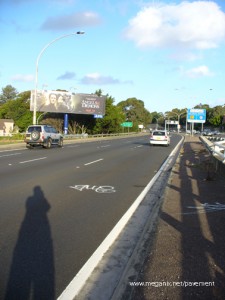
 Apart from a failed first year university class (and my weekly trash TV fix of Bones) I don’t really have any experience in the field of psychology, so I’m only making a vaguely educated guess when I say that the author/illustrator of this work is probably a paranoid schizophrenic.
Apart from a failed first year university class (and my weekly trash TV fix of Bones) I don’t really have any experience in the field of psychology, so I’m only making a vaguely educated guess when I say that the author/illustrator of this work is probably a paranoid schizophrenic. 
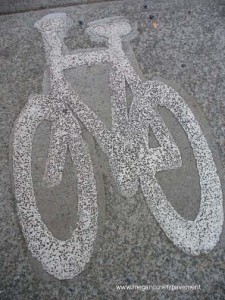 I love the pitted texture of this old bicycle symbol. It’s on a shared footpath (footpath?) near Erskineville Station. In the foreground of the wider shot there is a tag – or maybe it’s just a spill.
I love the pitted texture of this old bicycle symbol. It’s on a shared footpath (footpath?) near Erskineville Station. In the foreground of the wider shot there is a tag – or maybe it’s just a spill.
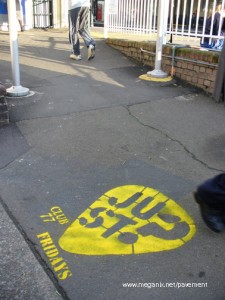 The dance party stencils are getting bigger and bolder. Around the middle of June ads for JUST? at Club 77 were sprayed all over inner-west pavements. Those in the know know where Club 77 is.
The dance party stencils are getting bigger and bolder. Around the middle of June ads for JUST? at Club 77 were sprayed all over inner-west pavements. Those in the know know where Club 77 is.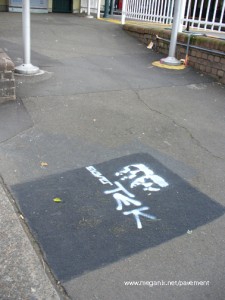
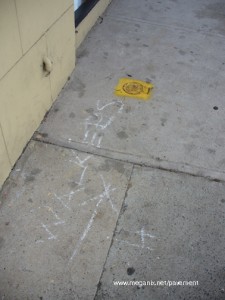 Arrow chases are the urban version of Hare and Hounds. Kids chalk arrows on the pavement instead of leaving paper trails, and Hash House Harrier clubs sometimes write esoteric instructions beside their arrows. I spotted the ‘Walkers’ arrow near Stanmore Station.
Arrow chases are the urban version of Hare and Hounds. Kids chalk arrows on the pavement instead of leaving paper trails, and Hash House Harrier clubs sometimes write esoteric instructions beside their arrows. I spotted the ‘Walkers’ arrow near Stanmore Station.
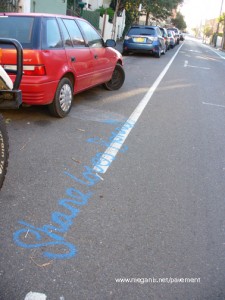 Every so often a large romantic message turns up on the pavement – sometimes on a country road, sometimes on a city street – turning private feelings into blaring headlines. Obviously premeditated and deliberately located so they will be seen by the object of affection (or disappointment), these messages can’t be compared with the miniature declarations of love made by wet cement opportunists. I believe they are generally written by males. Am I right?
Every so often a large romantic message turns up on the pavement – sometimes on a country road, sometimes on a city street – turning private feelings into blaring headlines. Obviously premeditated and deliberately located so they will be seen by the object of affection (or disappointment), these messages can’t be compared with the miniature declarations of love made by wet cement opportunists. I believe they are generally written by males. Am I right? 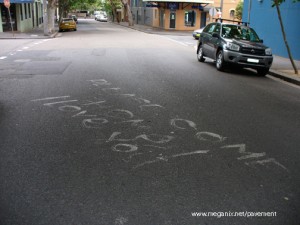
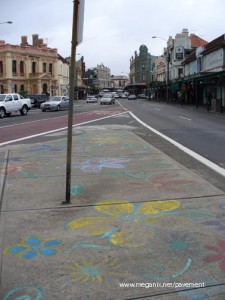 I wonder how many people know the story behind the coloured flowers on the traffic island at Newtown Bridge? They were originally painted during a day-long Reclaim the Streets party in November 1999, but if that were the whole story they would have worn off long ago. In fact, these flowers were deliberately preserved by friends of Kathy Jones.
I wonder how many people know the story behind the coloured flowers on the traffic island at Newtown Bridge? They were originally painted during a day-long Reclaim the Streets party in November 1999, but if that were the whole story they would have worn off long ago. In fact, these flowers were deliberately preserved by friends of Kathy Jones. 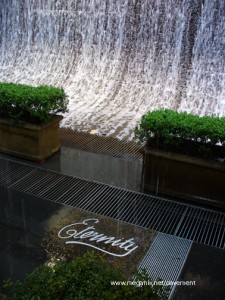 Sydney’s most famous pavement graffitist was Arthur Stace, a reformed no-hoper who walked the city’s streets writing the single copperplate word ‘Eternity’,
Sydney’s most famous pavement graffitist was Arthur Stace, a reformed no-hoper who walked the city’s streets writing the single copperplate word ‘Eternity’, 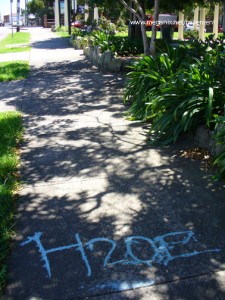 Dribble and splash are becoming more common as ways of writing pavement graffiti. H2OE was busy making large and small versions of his watery mark around
Dribble and splash are becoming more common as ways of writing pavement graffiti. H2OE was busy making large and small versions of his watery mark around 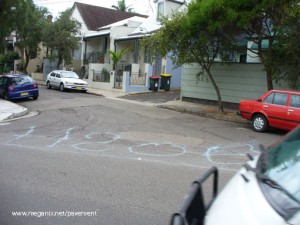
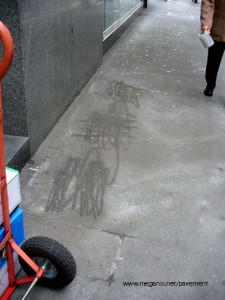 Over the years I have found York Street in the CBD to be a very fruitful site for pavement observation. Last week I spotted this line of scribbles near Barrack Street. These scribbles are not meaninglessÂ
Over the years I have found York Street in the CBD to be a very fruitful site for pavement observation. Last week I spotted this line of scribbles near Barrack Street. These scribbles are not meaningless 